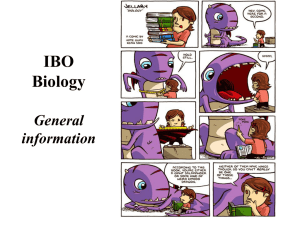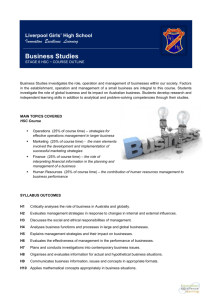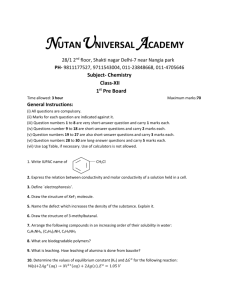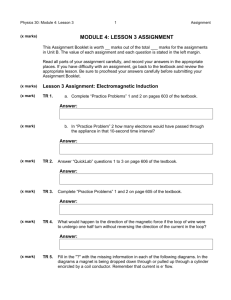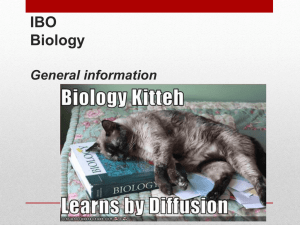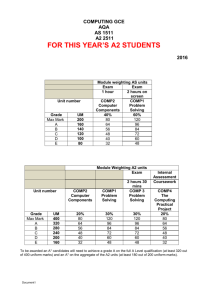Physics
advertisement
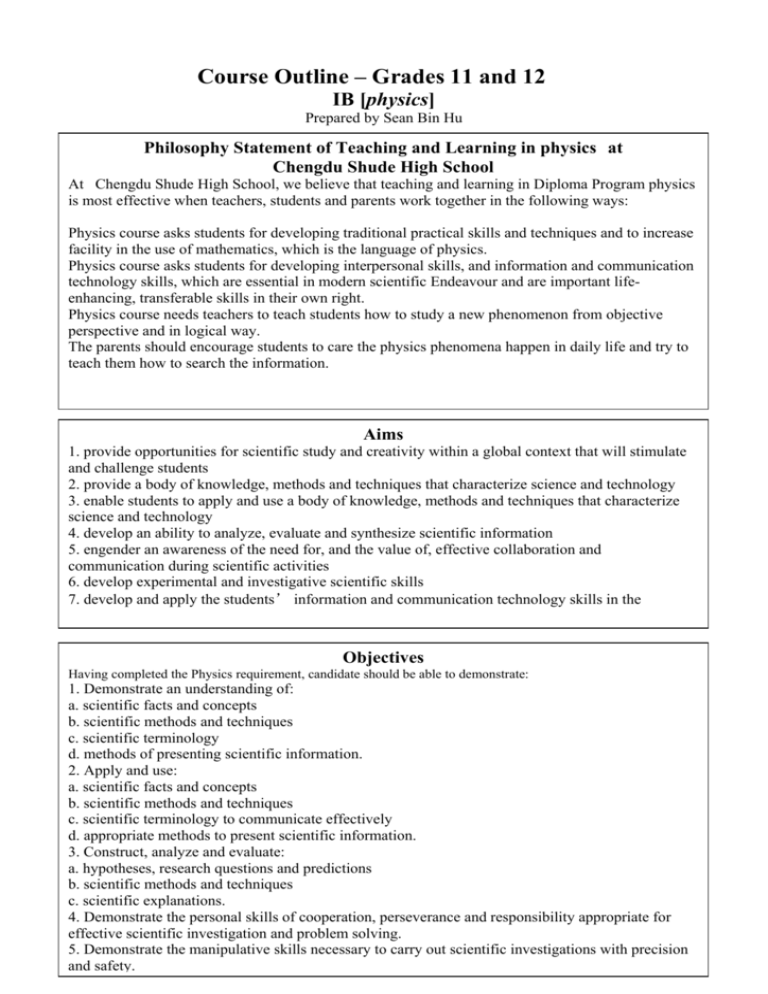
Course Outline – Grades 11 and 12 IB [physics] Prepared by Sean Bin Hu Philosophy Statement of Teaching and Learning in physics at Chengdu Shude High School At Chengdu Shude High School, we believe that teaching and learning in Diploma Program physics is most effective when teachers, students and parents work together in the following ways: Physics course asks students for developing traditional practical skills and techniques and to increase facility in the use of mathematics, which is the language of physics. Physics course asks students for developing interpersonal skills, and information and communication technology skills, which are essential in modern scientific Endeavour and are important lifeenhancing, transferable skills in their own right. Physics course needs teachers to teach students how to study a new phenomenon from objective perspective and in logical way. The parents should encourage students to care the physics phenomena happen in daily life and try to teach them how to search the information. Aims 1. provide opportunities for scientific study and creativity within a global context that will stimulate and challenge students 2. provide a body of knowledge, methods and techniques that characterize science and technology 3. enable students to apply and use a body of knowledge, methods and techniques that characterize science and technology 4. develop an ability to analyze, evaluate and synthesize scientific information 5. engender an awareness of the need for, and the value of, effective collaboration and communication during scientific activities 6. develop experimental and investigative scientific skills 7. develop and apply the students’ information and communication technology skills in the Objectives Having completed the Physics requirement, candidate should be able to demonstrate: 1. Demonstrate an understanding of: a. scientific facts and concepts b. scientific methods and techniques c. scientific terminology d. methods of presenting scientific information. 2. Apply and use: a. scientific facts and concepts b. scientific methods and techniques c. scientific terminology to communicate effectively d. appropriate methods to present scientific information. 3. Construct, analyze and evaluate: a. hypotheses, research questions and predictions b. scientific methods and techniques c. scientific explanations. 4. Demonstrate the personal skills of cooperation, perseverance and responsibility appropriate for effective scientific investigation and problem solving. 5. Demonstrate the manipulative skills necessary to carry out scientific investigations with precision and safety. Course Pre-requisites 1.have good arithmetic ability, 2.be able to solve usual math problems, 3.be able to give a clear explanation of a series of logical things, 4.be able to communicate with others easily, 5.have good cooperation ability with other students Content and Skills Example: Grade 11 SL + HL Physics and physical measurement Mechanics Thermal physics Oscillations and waves SL only Sight and wave phenomena HL only Electromagnetic waves Grade 12 SL + HL Electric currents Fields and forces Atomic and nuclear physics Energy, power and climate change SL only Electromagnetic waves HL only Astrophysics SKILLS: 1 Self-motivation and Perseverance :Approaches the project with self-motivation and follows it through to completion. 2 Working within a team:Collaborates and communicates in a group situation and integrates the views of others. 3 Self-reflection:Shows a thorough awareness of their own strengths and weaknesses and gives thoughtful consideration to their learning experience. Course Credits / Certificates awarded 3 course credits per year is granted to HL and SL students who successfully complete the course Students who opt to take the IB external examinations, either as part of the full IB Diploma or the Advanced High School Diploma, will gain an IB Certificate in Physics, if successful. Expectations Students are expected to: 1. Come to class prepared; read the assigned unit before the class. 2. Bring their writing textbook and notebooks every day. 3. Finish all the homework on time. 4. Always focus on the class and try to analyze independently for every problem. 5. Participate in class, be happy to share personal ideas to the others. 6. Try to understand the others’ ideas and be happy to discuss them . Textbooks and Materials used 1. 2. 3. 4. Pearson Baccalaureate Diploma Physics HL 2nd Edition OXFORDIB DIPLOMA PROGRAMME PHYSICS 2014 EDITION IB Question bank: Physics second edition Physics guide – For first examination 2016 Assessment Overview Most of this is taken from the subject guide. Tailor to your course Internal Assessment 20% General information The internal assessment requirements are the same for biology, chemistry and physics. The internal assessment, worth 20% of the final assessment, consists of one scientific investigation. The individual investigation should cover a topic that is commensurate with the level of the course of study. Student work is internally assessed by the teacher and externally moderated by the IB. The performance in internal assessment at both SL and HL is marked against common assessment criteria, with a total mark out of 24. Using the internal assessment criteria The new assessment model uses five criteria to assess the final report of the individual investigation with the following raw marks and weightings assigned: Personal engagement 2 (8%) Exploration Analysis Evaluation Communication Total 6 (25%) 6 (25%) 6 (25%) 4 (17%) 24 (100%) External Assessment 80% SL Paper 1 Duration: 3/4 hour Weighting: 20% Marks: 30 • 30 multiple-choice questions on core, about 15 of which are common with HL. • The questions on paper 1 test assessment objectives 1, 2 and 3. • The use of calculators is not permitted. • No marks are deducted for incorrect answers. • A physics data booklet is provided Paper 2 Duration: 1¼ hours Weighting: 40% Marks: 50 • Short-answer and extended-response questions on core material. • The questions on paper 2 test assessment objectives 1, 2 and 3. • The use of calculators is permitted. (See calculator section on the OCC.) • A physics data booklet is provided. Paper 3 Duration: 1 hour Weighting: 20% Marks: 35 • This paper will have questions on core and SL option material. • Section A: one data-based question and several short-answer questions on experimental work. • Section B: short-answer and extended-response questions from one option. • The questions on paper 3 test assessment objectives 1, 2 and 3. • The use of calculators is permitted. (See calculator section on the OCC.) • A physics data booklet is provided. HL Paper 1 Duration: 1 hour Weighting: 20% Marks: 40 • 40 multiple-choice questions on core and AHL, about 15 of which are common with SL. • The questions on paper 1 test assessment objectives 1, 2 and 3. • The use of calculators is not permitted. • No marks are deducted for incorrect answers. • A physics data booklet is provided. Paper 2 Duration: 2¼ hours Weighting: 36% Marks: 95 • Short-answer and extended-response questions on the core and AHL material. • The questions on paper 2 test assessment objectives 1, 2 and 3. • The use of calculators is permitted. (See calculator section on the OCC.) • A physics data booklet is provided. Paper 3 Duration: 1¼ hours Weighting: 24% Marks: 45 • This paper will have questions on core, AHL and option material. • Section A: one data-based question and several short-answer questions on experimental work. • Section B: short-answer and extended-response questions from one option. • The questions on paper 3 test assessment objectives 1, 2 and 3. • The use of calculators is permitted. (See calculator section on the OCC.) • A physics data booklet is provided. Key Dates Sep,2014 Grade 11 Grade 12: Topic 1: Measurements and uncertainties Topic 2: Mechanics Oct, 2014 Topic 2: Mechanics Nov, 2014 Topic 2: Mechanics Term 1 Topic 6: Circular motion and gravitation Dec, 2014 Topic 4: Waves Jan, 2015 Topic 4: Waves Topic 9: Wave phenomena semester exam Mar, 2015 Topic 9: Wave phenomena Apr, 2015 Topic 5: Electricity and magnetism May, 2015 Topic 5: Electricity and magnetism Topic 10: Fields Term 2 Jun, 2015 Topic 11: Electromagnetic July, 2015 Topic 11: Electromagnetic induction semester exam Sep,2015 Topic 3: Thermal physics Oct, 2015 Nov, 2015 Dec, 2015 Jan, 2016 Topic 7: Atomic, nuclear and particle physics Topic 12: Quantum and nuclear physics Topic 8: Energy production Option Term 3 semester exam Mar, 2016 Option General revision Apr, 2016 General revision May, 2016 IB test
